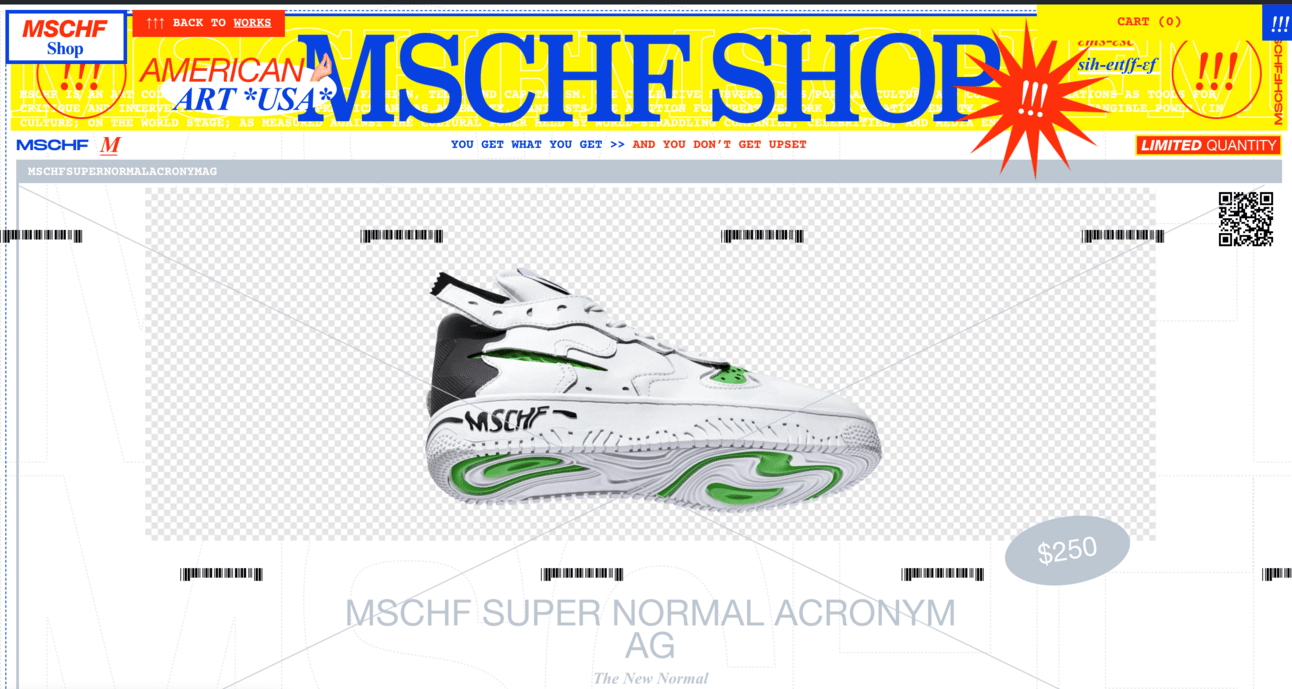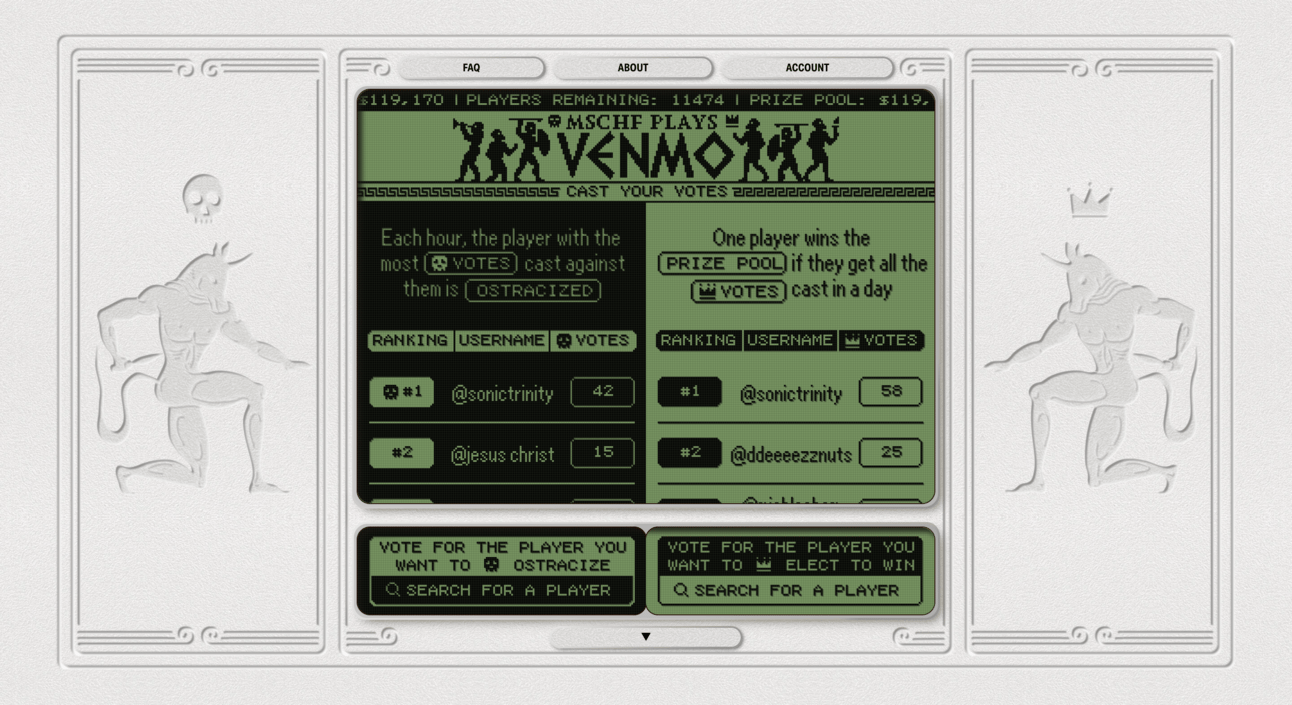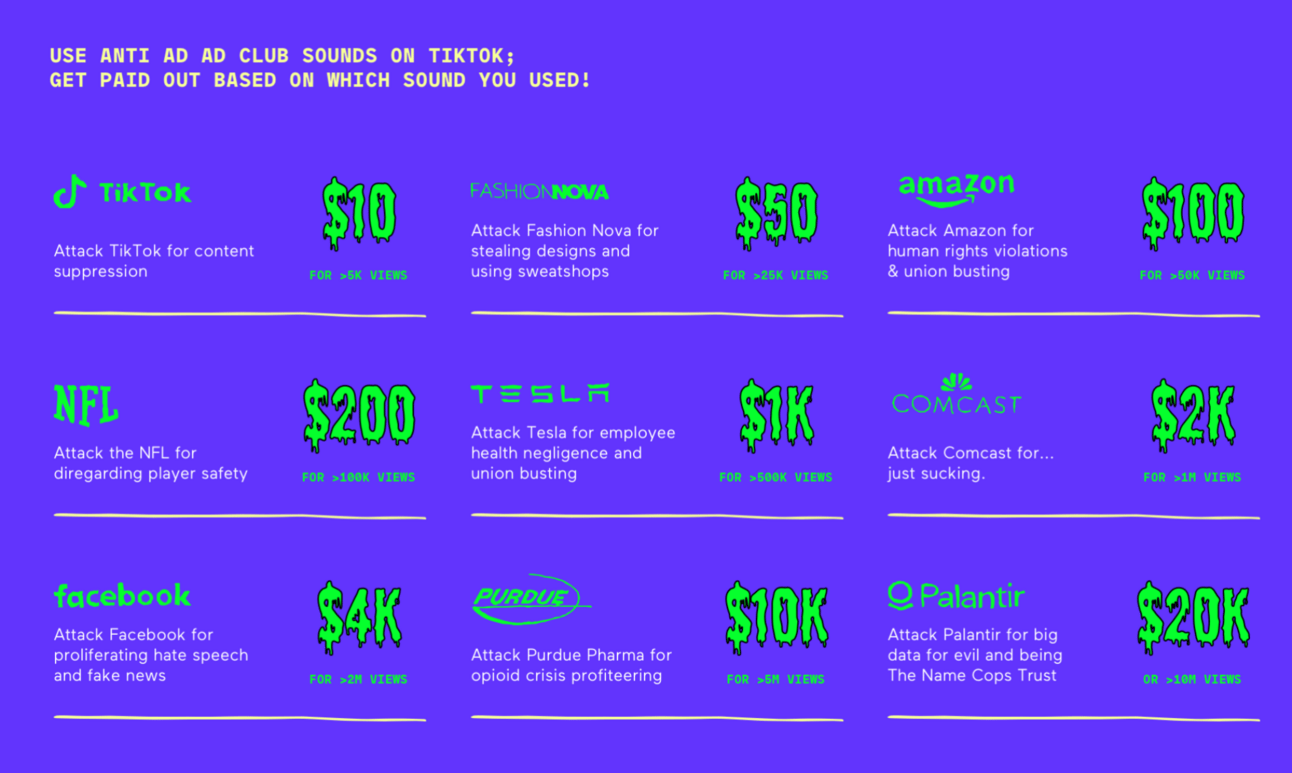- Ad Sense
- Posts
- MSCHF: Internet Zeitgeist or Marketing Machine?
MSCHF: Internet Zeitgeist or Marketing Machine?
MSCHF Maximalism & Its Grip On Our Internet Emotions
There’s always been a sense of the bizarre deeply integrated with the fabric of the internet and the extensive sub-cultures we see online in 2024. The social phenomenon of the meme says it all. Cutting through the thick of it all is MSCHF - a part product, part art, all bizarre brainchild of Gabe Whaley. Whaley built a system so powerful it carved itself into the internet zeitgeist, and it can’t stay off your timeline. Rather than relying on any particular product or service to drive success, the collective takes a nuanced approach mixed with strong fundamentals to fuel their viral loops and hype engine. You most likely entered the MSCHF paradigm when the insatiable Big Red Boot hit everyone’s timeline. Said Big Red Boot(s):

Garrett Bruce - MSCHF
Internet For Internet
In MSCHF’s early years, Whaley focused on continuously and consistently generating content to generate millions of clicks. This is back in the glory days approx. 2013-2019. You know, back when life wasn’t so complicated, the dollar menu was ole reliable, and Twitter was funny. In those glorious times, Whaley was laying the foundations that launched MSCHF into making internet history. Before the late-stage content farms populating theiPpad kids of today, Whaley was mashing together ideas in the pursuit to “create internet for the internet” as he puts it. Being a true, early internet maximalist. Embracing the extremes in breaking the boundaries of how to rear and control the emotions of the internet.
Mastering The Micro-trend
MSCHF’s outward model is simple enough, maintain virality through selling unique, limited products/services/thought experiments that drive more virality. A content engine that perpetuates its very own viral loop. The impressions generate themselves since their releases generally always provoke the internet to react. With the internet on a digital leash, Whaley commands all eyes to stop and witness his lab of mad scientists at work. These kinds of scientists are studying the internet under a microscope, to keep finding ways to feed their viral loop. We’ll get into that later, for this moment I want you to step back and look at the whole picture. MSCHF’s success is directly correlated to how they’ve created and pertained their public image. Whaley and his team of creatives are viewed as closer to mad scientists than they are to marketers, and that’s the point. MSCHF projects ambiguity and outrage through its work, and just like how light acts as a wave and particle, MSCHF acts as a product producer and content farm at the same time. No one can definitively call light a wave or particle or MSCHF an e-commerce company, design studio, or marketing agency, they transcend the boundaries of any one descriptor or definition. MSCHF innovation comes in their drops acting as both product and content, allowing them to essentially start and end their proprietary microtrends. Their products and ideas are designed for the micro-trend. With their release schedule being every two weeks, every drop has a proven potential to generate buzz that will either die out in two weeks (easy mode) or grow large enough to enter the internet zeitgeist.
Whaley's genius comes in the mastering of the micro-trend. With every release, MSCHF successfully creates a micro-trend for influencers to feast on. Think of all the companies that can create their own trends on-demand, a full monopoly of the content life cycle, there aren’t many…if any on the scale of MSCHF. They see that influencers create niche follower bases and have the reach to influence their small circles. Instead of throwing pebbles in the pond, MSCHF yeats a big boy boulder to make a wave for all the little influencer fish to ride on, and only then do the sharks come out to feast. The boulder being their releases that provoke curiosity through meshing internet cultures into their concepts. Whaley aims to maximize the content culture by doing all the heavy lifting. They give internet personalities a product with all the content built-in, all they have to do is interact with it. This is why with every release comes a barrage of influencers reviewing, discussing, and fit-checking some sweet ole MSCHF dope. Therein lies why Whaley seeks to blur the lines between product and content. If able to attain an MSCHF product, the small fish are granted a limited product, with an ambiguous feature or outrageous design elements that, when showcased through Instagram, Tiktok, etc., generate the audience engagement necessary for the small influencers to grow. Products that run through this funnel generate the buzz that incentivizes the big fish to capitalize on the growing hype. The internet does not interact with every product or idea the same, yet this example shows the power of mastering the micro-trend and how it may unlock the door to starting the macro-trends every company’s marketing department dreams of creating.
Micro → Macro
It’s not just influencers, any entity engaging online from commenter to broadcaster is in MSCHF’s sights. They seek to manipulate and maximize a content feedback loop, by seeing what provokes, sways, and empowers internet communities to react…almost like an internet maximalist. Not a manipulation in a malicious way, but rather a manipulation of digital reality, distorting what is and isn’t possible through the internet. Like how Reddit and FourChan provide a space for online communities to be expressed and empowered through the platforms, MSCHF does the same through their output though in a more nuanced, pop culture kind of way. I call this MSCHF Maximalism. The special sauce for this type of maximalism is the observance and utilization of internet emotions, to further and solidify MSCHF as an internet zeitgeist. Much like a partner, it’s amazing what can happen when emotions are acknowledged and acted on. And like an internet lover, they watch, engage, and create based on the emotions of the masses online. This all loops around to MSCHF’s meditation on making internet for the internet in the pursuit of MSCHF Maximalism. Let’s dissect a couple of rather ~interesting~ and innovative ideas to come as a result of this maximalism to get a better picture.
MSCHF Maximalism
Take us back to when you could SURF the internet. Browsing results pages and clicking random links…only to download malware. Okay, maybe it’s not always a fun time, but it was a thing people did for fun. Surfing the web was a new way to explore and engage with this evolving digital medium, and only through exploring the world wide web, could find and establish a real sense of the quintessential “internet”. This is the idea of the internet MSCHF emulates and strives to create. Random, bizarre, niche sites for anything and everything. MSCHF wraps itself with the internet aesthetic, injecting a piece of this design into all they do. This can be seen most clearly when taking a glance at their homepage.

mschf.com (Homepage)
Splattered with high-contrast graphics and hyperlinks, their homepage is closer to a visual assault than an inviting shopping experience. It screams INTERNET. The design is an obvious nod to the early visual design of the early internet but with a modern twist, and with this composing a piece of their brand identity, MSCHF frames definitively for the consumer that this IS a company made by and for the internet. This then lays the groundwork for signaling the motif of MSCHF maximalism, the rest of the puzzle is contained in their works.
From a general marketing standpoint, these design cues are counterintuitive, too much clutter and chaos for there to be a comfortable shopping experience. But it’s MSCHF so it works. It may come off as simple signaling or their own built up gimmick, but there’s much much more than what meets the eye…literally. When you enter the MSCHF website they are inviting you and transporting you into their own ecosystem of internet - once on their landing page you have transversed a portal into their realm. Through this, they are able to evoke the same sense of wonder felt from stumbling upon a random and interesting site when surfing the web.
In this, we see the first internet emotions MSCHF acts upon. Your sense of nostalgia and wonder associated with the internet. Their target audience is people familiar with these feelings, and they target it expertly through their visual design. Their true power comes in this form of framing which ends up acting on you consciously and subconsciously. This framing surrounds every picture MSCHF paints through the work produced by the collective, cutting through stale brand identity cues with their own redefinition of what internet and art can be ie MSCHF Maximalism. A true universe in a nutshell.
Ancient Ostracism
MSCHF recently decided to revive an ancient practice with some modernity. The people of Athens used to hold a vote to ostracize a notable figure from Athens for ten years. They would do this to ensure that if anyone became too powerful or problematic, they could be removed for the sake of the greater good. Kind of makes you wish we kept the tradition alive… Well, MSCHF has brought the practice into 2024 through Venmo.
It is a game with a +$100,000 prize pool that can only be won if you unanimously get elected to win the prize pot, all you need is a Venmo account. Sign-ups are closed but here is a peep into their proprietary site created for this work, drop #110, MSCHF Plays Venmo:

MSCHF Plays Venmo (Homepage)
Players cast votes hourly to decide who to ostracize and daily to decide the winner. MSCHF pushes you to utilize the Venmo platform to communicate with other players and game the system. A marketing dub for Venmo, collabing with MSCHF gives them in this way boosts all stages of the funnel, but that’s obvious enough…
Add Me On Venmo
Why Venmo? They just let you send money to people, right, so how are they even relevant to the game?
Yes, Venmo is mainly a peer-to-peer payment platform, but MSCHF found value in Venmo's social media skin wrapping the payment platform. Your account is linked to your username, like X and Instagram, and when you send money you HAVE TO include a note of some kind. I used to play 4D Chess by sneak dissing people through my Venmo notes…what a toxic time. While the mandatory note can be tedious, it creates a more social aspect of the platform, making it a perfect platform to facilitate this competition. This is further shown in the last pieces of info MSCHF provides on the contest’s website. After reading all the information about the game/contest, at the very bottom, there is a section titled “Break The Rules”. Okay, now at the very end of THAT section, the very last sentence reads,
“Send someone one cent and you can send a message. Send a message, and perhaps you can make an ally. Make an ally and perhaps you can game the vote.”
The key to winning almost $120K is to make allies by utilizing Venmo to find and communicate with other participants to game the system. Tremendous work on MSCHF’s part in marketing Venmo’s use cases, no doubt, but these allies can be made elsewhere…on the internet! Peeling back this blue curtain reveals MSCHF’s grand design for their maximalism, and how these works serve as perpetuators of this maximalism.
More Internet → More Maximalism
MSCHF Plays Venmo is another instance in the long history of MSCHF engaging and creating more internet. In this case, it is literally more internet because this game has its own proprietary site separate from the main MSCHF site. The game by design is supposed to push participants to interact through the internet and game the system in whatever way possible. MSCHF knows that people online have a tendency to unify and act very quickly through the medium, especially in the act of solving a mystery or puzzle. I’m sure you’ve heard of the Reddit and 4chan detectives solving crimes the police couldn’t. Truly amazing how the internet can bring people together, partly due to an internet emotion of belonging, an extension of our true desire to be accepted and contribute to a cause/purpose of our community [1].
MSCHF approaches the internet and the emotions hosted on it in this gaze. Digital marketing usually fails to acknowledge this nuance of the internet, resulting in fierce backlash online - recall the time when the marketing teams of popular brands thought it was a good idea to be depressed and horny on X. MSCHF isn’t just marketing on the internet, they identify as being part of the internet; what others consider marketing they consider part of their identity as an entity. In this, they can understand the internet and people’s emotions on the internet, ultimately creating mediums through their works and products that acknowledge, proliferate, and most importantly empower people to engage on the internet aka MSCHF maximalism. In MSCHF Plays Venmo, they understand that people online will interact and spread the idea if given the right medium and incentive. MSCHF wants people to game the system. They are promoting interaction and discussion online with their names attached. The MSCHF maximalist model.
MSCHF maximalism is the pivotal factor contributing to their success as more than just some e-commerce company or art collective, but an internet zeitgeist. They could not exist separately from the culture of the internet we see today, they are reliant on it because they have integrated themselves to be one with it. That is why I call it MSCHF maximalism, very similar to internet maximalism but it differs in the way that the driver of the maximalism is MSCHF’s universe on the internet. The more they create internet, the more MSCHF there will be, and the more people that interact with MSCHF, the more people will create internet for MSCHF to draw from. This is their hype engine, fully fueled by internet emotions.
Creating Mischief
How many ads do you think you see a day? 50? 100? Maybe 250? The Forbes Article Finding Brand Success In The Digital World by Jon Simpson claims “Digital marketing experts estimate that most Americans are exposed to around 4,000 to 10,000 ads each day”. This means that the thousands of dollars in ad spend, going to an audience of consumers utterly engulfed in ad fatigue, don’t reach their target audience efficiently. Once the advertising algorithms figure out the products you are in the market for, you aren’t just exposed to more of the product, you are bombarded with ads from either the same handful of ads or a selection so wide your decision as to where to spend your money becomes increasingly difficult. This bombardment leads to consumers phasing out most of the ads thrown their way, causing their purchasing decisions to be made on a more subconscious than conscious level.
MSCHF acts as the antithesis to all this. Most apparent in their 2020 drop #31 Anti Ad Ad Club (AAAC), a playful spin on the hype beast brand Anti Social Social Club, they were so fed up with the sponsored post shilling overtaking social media that they paid people to share posts criticizing major companies facilitating the shilling for their blatant abuse and hypocrisy. Here’s their manifesto for this work for whoever is interested. Their payment structure says it all:
20K to bad mouth a company with terrible practices seems like a sweet deal! Works like these are quintessential to furthering MSCHF maximalism and ultimately breaking the stale marketing practices polluting our screens.
MSCHF doesn’t deal with ad spend, their output bakes the marketing into the drop. By design, their works just existing through MSCHF alone gives it all the juice it needs to organically hit your timeline. Traditionally marketing is done through digital channels, ideally your product molds to the channel for the best results. MSCHF throws that out the window opting to instead produce works that resonate with users or groups on the internet. The internet subculture now becomes the marketing channel, and the work associated with the subculture becomes the marketing funnel. In AAAC’s instance, the channel is the viewer or influencers exposed to the pestilence of influencer/sponsored marketing. Yes, they are paying the people who engage with AAAC, but with every post, MSCHF’s name is attached to the post ultimately completing the circle of the work self-marketing MSCHF. This personalized internet culture funnel always feeds into the larger funnel that is MSCHF: their own universe of internet culture they have built and curated to indoctrinate consumers into. The hype engine keeps feeding viral loops that in turn keep fueling the engine.
Big Picture
The proof is in the pudding. Marketers cannot ignore the internet identity and the significance this identity plays in the drivers and purchases of consumers online. In 2024’s digital landscape, hundreds of brands are piling into the marketplace looking to get more views and clicks to hopefully achieve a sliver of the virality MSCHF continues to produce.
Contemporary marketing is stale because it has begun to increasingly fail at understanding the perspective of the consumer. It aims to emulate it, but like gas station sushi, it rarely hits the spot. Insights and metrics dictate the way marketing strategies are proliferated and executed, it’s a fictionalized and narrow approach, that would work…if you discount ad fatigue. The problem comes down to the competition present within today’s digital marketplace. It’s not just companies duking it out in product sales, the majority of companies that are on a path to success or are already succeeding are funding their marketing department to the gills, which creates a competitive ad market. Great for people profiting off delivering ads, but all this money in ad spend is diluting the marketing power of your ads to drive engagement and conversion. This comes at the consumer’s mental cost, having so many ads thrown in their face daily that their brains are getting better and better at blocking them out. There needs to be another way…and maybe, just maybe, taking a step back to actually pay attention to the actual people and personalities that consume your product could lead to an answer.
Internet Awareness
Engaging with your target audience in order to understand their internet identity should be of utmost importance. Understanding your audience’s internet emotions is what will take your marketing game from checkers to chess. The customer persona should acknowledge and consider the personalities of these customers online, and the associations that they tend to identify with. Neglecting to do so only allows marketing strategies to be composed of media that only partially resonate with your prospective customers. Looking at the viral sensation Zyn, we see a strong culmination of internet spheres associating themselves with the nicotine pouch and driving more attention and consumption of Zyns to the point where there is a total shortage at the time of this writing. From frat bros to finance bros, there are whole subcultures of people who consume content based on their self-ascribed groups online, why wouldn’t they make purchasing decisions along this axis as well? Closing this gap between your brand/product identity and consumer identity online is key. The attention to the market psychology, in the context of the internet, MSCHF finds success through can take shape in many brands today, and MSCHF is doing nothing but understanding this and utilizing it to its advantage.
Great, super obvious, easy to do stuff huh? Okay okay, to get to this level of marketing you need people on your team who are in the know, the chronically online. I know all our managers hate when we slack on our phones instead of doing the necessary work at hand, but I’m saying they should start rewarding the digital dwellers. They will serve the purpose of pinpointing exactly how your brand fits into the internet ethos, and if there is a lack of that, they create it. They work to learn and know the ins and outs of your brand’s online community, using this knowledge to provide critical insight and additional context for creating marketing materials. Just like Reddit moderators but for your brand’s existence on the whole internet and social media. Social Media Managers are great and, in theory, should be able to provide this insight, but ultimately they will always play by the traditional rules adhering to brand guidelines and content calendars.
If the brand has no presence or ethos online then make it. No one gave MSCHF the right to become part of the internet zeitgeist, they just did. Starting from scratch will help in applying these nuance concepts found in MSCHF. It will be difficult and not linear, but the act of trying alone will produce something new and interesting - that can maybe one day be developed into a hype engine of its own. The new and interesting stuff will freshen things up for those of us subjected to the ad spend, and your customer base will get a better chance to resonate with the products or services they love. The internet, much prettier than it used to be, is still an evolving Wild West, so go wild it might make some mischief.
The efforts to understand consumers and their expression online will lead to a more insightful, personal, and meaningful representation of the consumer in marketing, leading to the creation of attainable objectives and unique strategies. Viral success isn’t magic, it is orchestrated luck, and this approach gives the luck factor less leverage over the possibility of virality because the marketing team is in deep touch with who and why your products would resonate with the masses online, making anything they market more likely to achieve viral success.
1 Now I’m not saying that everyone’s reason for interacting and choosing to be part of things like this is due to a deeper need of belonging. The motivator to join this competition is the money. In this discussion of internet emotions, I am alluding to the instances of the internet being a cultural reality separate from the “real” world or society. Our interactions online are not fully reflective of who we are as people, the anonymity of the internet allows us to exercise a true self-regulated version or part of ourselves. Reacting to things online, in the form of voting on polls, leaving comments, joining MSCHF Plays Venmo, etc., can be a truer form of an indicator of how people feel about virtually anything. That’s why X (Twitter) is such a powerful place for people’s voices online. You may not be able to say how you feel about a political candidate at the dinner table, but you sure as hell can say it…and more…on X.
